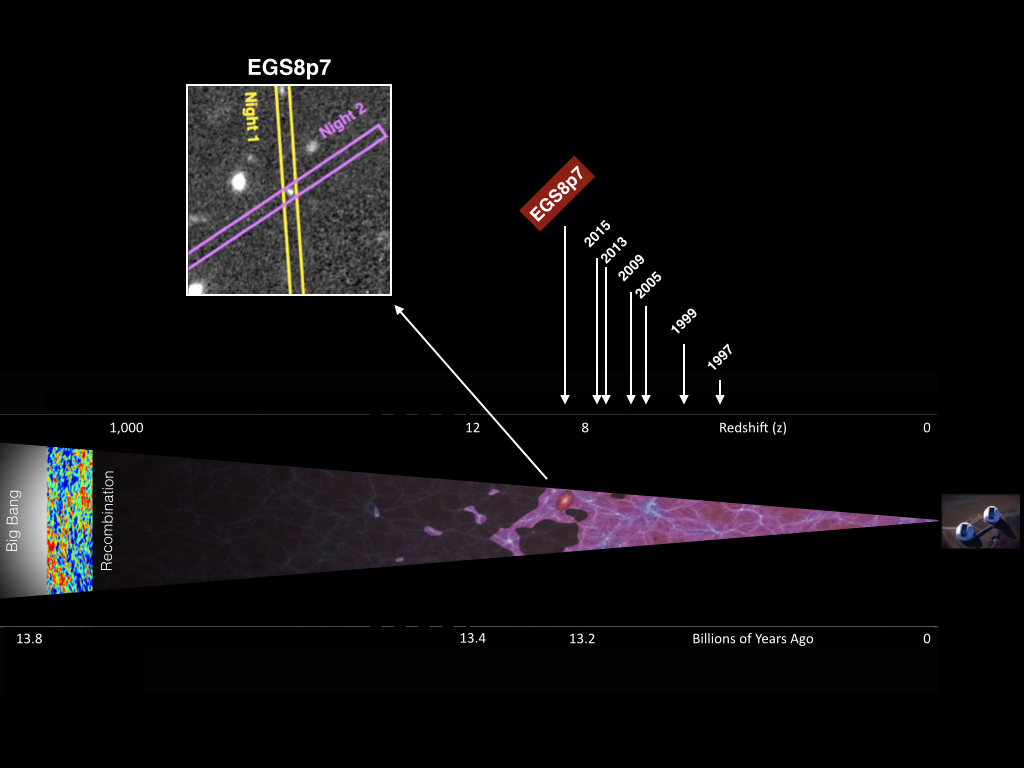
Astronomers found the most far-flung galaxy ever discovered, NASA's Curiosity rover celebrated three years on Mars and Europe's Rosetta mission marked one year in orbit around a comet. Here are Space.com's top stories of the week.
The universe's most distant galaxy
Astronomers have spotted the farthest-flung galaxy in the known universe. The newfound galaxy, known as EGSY8p7, lies about 13.2 billion light-years from Earth — meaning astronomers are now seeing the mass of stars as it existed just 600 million years after the Big Bang that created the universe. [Full Story: Ancient Galaxy Is Most Distant Ever Found]
Curiosity rover marks 3 years on Mars
NASA's Mars rover Curiosity has now been trundling across the Red Planet for three very productive and eventful years. Curiosity landed on the night of Aug. 5, 2012, pulling off a dramatic and unprecedented touchdown with the aid of a rocket-powered "sky crane" that lowered the 1-ton rover gently to the Martian surface via cables. [Full Story: 3 Years on Mars! Curiosity Rover Reaches Milestone]
Happy anniversary, Rosetta
Get the Space.com Newsletter
Breaking space news, the latest updates on rocket launches, skywatching events and more!
On Aug. 6, 2014, the European Space Agency's Rosetta probe arrived at Comet 67P/Churyumov–Gerasimenko. The spacecraft immediately began studying the comet and mapping its surface, in part to find a good site for Rosetta's onboard lander, Philae, to touch down. [Full Story: Rosetta 1 Year Later: Historic Comet Mission Still Intrigues]
Names unveiled for new Pluto, Charon maps
The team behind NASA's New Horizons spacecraft, which performed the first-ever Pluto flyby last month, has unofficially named some craters on the dwarf planet's big moon Charon after characters from the "Star Wars" and "Star Trek" universes. [Full Story: Vader Crater, Kirk & Spock! 'Star Wars,' 'Star Trek' Collide on Pluto Moon]
What will New Horizons' legacy be?
NASA's New Horizons Pluto mission should leave a rich scientific legacy, and could help spur future ambitious exploration efforts throughout the solar system, researchers say. [Full Story: How Will NASA's New Horizons Mission to Pluto Be Remembered?]
False positives could make detecting alien life tricky
Scientists are working hard to come up with ways to disprove claims of life elsewhere in the universe, because nobody wants to be the one who gets it wrong. [Full Story: Is That Really Alien Life? Scientists Worry Over False-Positive Signs]
Jeff Bezos restores Saturn V moon rocket engines
The historic F-1 rocket engines that once launched NASA's Apollo astronauts to the moon on the Saturn V rocket have been restored by Jeff Bezos. [Full Story: Apollo Moon Rocket Engines Recovered by Amazon CEO Preserved for Display]
Tiny cubesat headed to the moon
NASA has greenlit a mission that will send a tiny "cubesat" to search for moon water from lunar orbit. The Lunar IceCube mission will likely launch in 2018, on the first flight of NASA's Space Launch System megarocket. [Full Story: Tiny Cubesat Will Hunt for Water Ice on the Moon]
The most Earth-like exoplanets: NASA's list
While a true "Earth twin" remains elusive, here are what NASA considers to be the six closest exoplanet analogues to our home planet. [Full Story: The 6 Most Earth-like Alien Planets]
'Protogalactic disk' spotted for first time
For the first time, astronomers have spotted a protogalactic disk — a giant whirling cloud of gas that gives birth to a galaxy — and the discovery could reveal clues about how galaxies form. [Full Story: Monstrous Whirling Gas Cloud Reveals Clues About Galaxy Formation]
Drones on Mars?
A team of NASA engineers wants to put drones on Mars. These flying robotic sentinels could reach more of the Martian surface, and possibly solar system moons or the dark, sunless craters on asteroids. [Full Story: Drones in Space! NASA's Wild Idea to Explore Mars (Video)]
Gigantic ring of galaxies puzzles scientists
Astronomers have announced the discovery of a truly monstrous structure consisting of a ring of galaxies around 5 billion light-years across — and it defies cosmological theory. [Full Story: Giant Mystery Ring of Galaxies Should Not Exist]
Follow Mike Wall on Twitter @michaeldwall and Google+. Follow us @Spacedotcom, Facebook or Google+. Originally published on Space.com.
Join our Space Forums to keep talking space on the latest missions, night sky and more! And if you have a news tip, correction or comment, let us know at: community@space.com.

Michael Wall is a Senior Space Writer with Space.com and joined the team in 2010. He primarily covers exoplanets, spaceflight and military space, but has been known to dabble in the space art beat. His book about the search for alien life, "Out There," was published on Nov. 13, 2018. Before becoming a science writer, Michael worked as a herpetologist and wildlife biologist. He has a Ph.D. in evolutionary biology from the University of Sydney, Australia, a bachelor's degree from the University of Arizona, and a graduate certificate in science writing from the University of California, Santa Cruz. To find out what his latest project is, you can follow Michael on Twitter.









